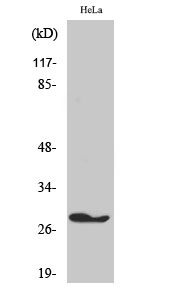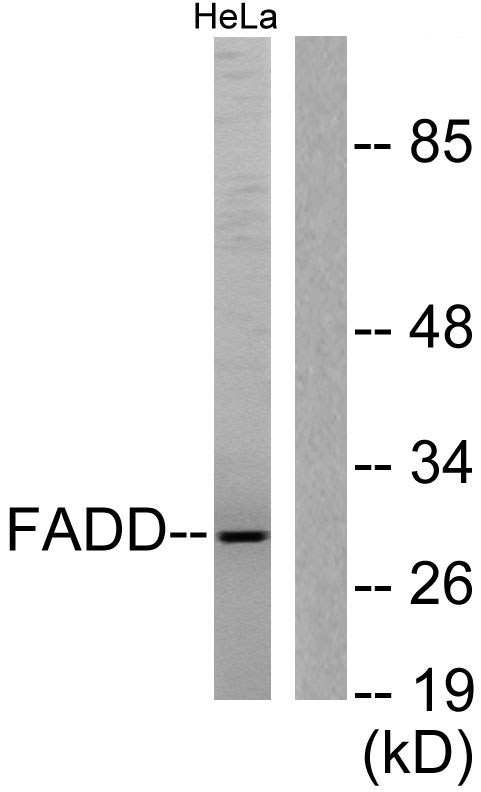FADD Polyclonal Antibody
- Catalog No.:YT1656
- Applications:WB;IHC;IF;ELISA
- Reactivity:Human;Mouse
- Target:
- FADD
- Fields:
- >>Platinum drug resistance;>>Apoptosis;>>Apoptosis - multiple species;>>Necroptosis;>>Toll-like receptor signaling pathway;>>NOD-like receptor signaling pathway;>>RIG-I-like receptor signaling pathway;>>IL-17 signaling pathway;>>TNF signaling pathway;>>Alcoholic liver disease;>>Alzheimer disease;>>Pathways of neurodegeneration - multiple diseases;>>Pathogenic Escherichia coli infection;>>Salmonella infection;>>Chagas disease;>>Tuberculosis;>>Hepatitis C;>>Hepatitis B;>>Measles;>>Human cytomegalovirus infection;>>Influenza A;>>Human papillomavirus infection;>>Kaposi sarcoma-associated herpesvirus infection;>>Herpes simplex virus 1 infection;>>Epstein-Barr virus infection;>>Human immunodeficiency virus 1 infection;>>Pathways in cancer
- Gene Name:
- FADD
- Protein Name:
- Protein FADD
- Human Gene Id:
- 8772
- Human Swiss Prot No:
- Q13158
- Mouse Swiss Prot No:
- Q61160
- Immunogen:
- The antiserum was produced against synthesized peptide derived from human FADD. AA range:159-208
- Specificity:
- FADD Polyclonal Antibody detects endogenous levels of FADD protein.
- Formulation:
- Liquid in PBS containing 50% glycerol, 0.5% BSA and 0.02% sodium azide.
- Source:
- Polyclonal, Rabbit,IgG
- Dilution:
- WB 1:500 - 1:2000. IHC 1:100 - 1:300. ELISA: 1:5000.. IF 1:50-200
- Purification:
- The antibody was affinity-purified from rabbit antiserum by affinity-chromatography using epitope-specific immunogen.
- Concentration:
- 1 mg/ml
- Storage Stability:
- -15°C to -25°C/1 year(Do not lower than -25°C)
- Other Name:
- FADD;MORT1;GIG3;Protein FADD;FAS-associated death domain protein;FAS-associating death domain-containing protein;Growth-inhibiting gene 3 protein;Mediator of receptor induced toxicity
- Observed Band(KD):
- 28kD
- Background:
- The protein encoded by this gene is an adaptor molecule that interacts with various cell surface receptors and mediates cell apoptotic signals. Through its C-terminal death domain, this protein can be recruited by TNFRSF6/Fas-receptor, tumor necrosis factor receptor, TNFRSF25, and TNFSF10/TRAIL-receptor, and thus it participates in the death signaling initiated by these receptors. Interaction of this protein with the receptors unmasks the N-terminal effector domain of this protein, which allows it to recruit caspase-8, and thereby activate the cysteine protease cascade. Knockout studies in mice also suggest the importance of this protein in early T cell development. [provided by RefSeq, Jul 2008],
- Function:
- domain:Contains a death domain involved in the binding of the corresponding domain within Fas receptor.,function:Apoptotic adaptor molecule that recruits caspase-8 or caspase-10 to the activated Fas (CD95) or TNFR-1 receptors. The resulting aggregate called the death-inducing signaling complex (DISC) performs caspase-8 proteolytic activation. Active caspase-8 initiates the subsequent cascade of caspases mediating apoptosis.,PTM:Phosphorylated.,similarity:Contains 1 death domain.,similarity:Contains 1 DED (death effector) domain.,subunit:Interacts with CFLAR, PEA15 and MBD4. When phosphorylated, part of a complex containing HIPK3 and FAS. May interact with MAVS/IPS1. Interacts with MOCV v-CFLAR protein and LRDD.,tissue specificity:Expressed in a wide variety of tissues, except for peripheral blood mononuclear leukocytes.,
- Subcellular Location:
- cytoplasm,cytosol,plasma membrane,death-inducing signaling complex,CD95 death-inducing signaling complex,neuron projection,cell body,membrane raft,ripoptosome,
- Expression:
- Expressed in a wide variety of tissues, except for peripheral blood mononuclear leukocytes.
Meloxicam Inhibits Apoptosis in Neurons by Deactivating Tumor Necrosis Factor Receptor Superfamily Member 25, Leading to the Decreased Cleavage of DNA Fragmentation Factor Subunit α in Alzheimer’s Disease
Targeting FoxM1 by thiostrepton inhibits growth and induces apoptosis of laryngeal squamous cell carcinoma. JOURNAL OF CANCER RESEARCH AND CLINICAL ONCOLOGY 2014 Nov 13 WB Human Hep-2 cell
The preparation of a cold-water soluble polysaccharide from Grifola frondosa and its inhibitory effects on MKN-45 cells. GLYCOCONJUGATE JOURNAL 2020 Jun 15 WB Human MKN-45 cell
Down-regulation of FoxM1 by thiostrepton or small interfering RNA inhibits proliferation, transformation ability and angiogenesis, and induces apoptosis of nasopharyngeal carcinoma cells. International Journal of Clinical and Experimental Pathology Int J Clin Exp Patho. 2014; 7(9): 5450–5460 WB Human Nasopharyngeal carcinoma (NPC) cell
- June 19-2018
- WESTERN IMMUNOBLOTTING PROTOCOL
- June 19-2018
- IMMUNOHISTOCHEMISTRY-PARAFFIN PROTOCOL
- June 19-2018
- IMMUNOFLUORESCENCE PROTOCOL
- September 08-2020
- FLOW-CYTOMEYRT-PROTOCOL
- May 20-2022
- Cell-Based ELISA│解您多样本WB检测之困扰
- July 13-2018
- CELL-BASED-ELISA-PROTOCOL-FOR-ACETYL-PROTEIN
- July 13-2018
- CELL-BASED-ELISA-PROTOCOL-FOR-PHOSPHO-PROTEIN
- July 13-2018
- Antibody-FAQs
- Products Images

- Western Blot analysis of various cells using FADD Polyclonal Antibody diluted at 1:500

- Immunohistochemistry analysis of paraffin-embedded human lung carcinoma tissue, using FADD Antibody. The picture on the right is blocked with the synthesized peptide.

- Western blot analysis of lysates from HeLa cells, treated with PMA 125ng/ml 30', using FADD Antibody. The lane on the right is blocked with the synthesized peptide.



